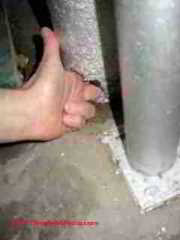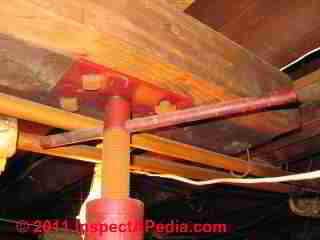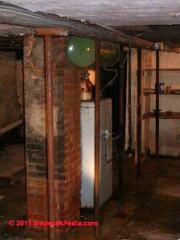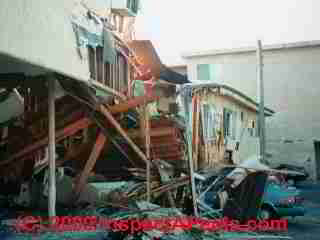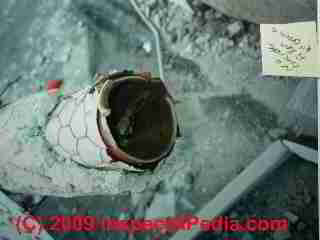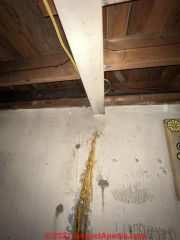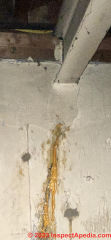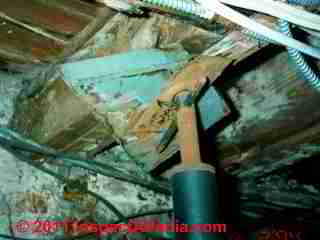 Structural Column & Pier Defects
Structural Column & Pier Defects
- POST a QUESTION or COMMENT about the types of structural column failure in residential & light commercial buildings: inspection, diagnosis, & repair
Structural column defects:
This article explains how to notice defective, damaged, improperly supported, or missing structural columns, and other structural column & pier mistakes.
Here we will discuss missing structural column or post footings & piers, missing Lally columns that were removed during remodeling, use of temporary columns & jackposts, Improper bearing support at Lallys & teleposts. We include photographs of structural column mistakes. We explain how to evaluate rust damage to steel columns, posts, adjustable columns in homes,
Our page top photo shows a telepost used as a "permanent" supporting column. Most models of teleposts or "jackposts" are thin-walled steel and are not designed for permanent use. And all columns require proper bearing support at both the column top and bottom. This leaning, cockeyed jackpost is a structural collapse waiting to happen.
Detecting omissions, such as leaving out a column or it's pier or footing is an important step in learning how to recognize and diagnose various types of foundation failure or damage, such as foundation cracks, masonry foundation crack patterns, and moving, leaning, bulging, or bowing building foundation walls.
InspectAPedia tolerates no conflicts of interest. We have no relationship with advertisers, products, or services discussed at this website.
Structural Columns in Residential Buildings: Visual Inspection for Defects
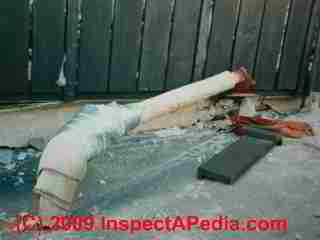 This article describes a structural column defects in residential buildings. Larger structures using supporting columns and piers certainly require additional professional design from a civil or structural engineer or similar design professional.
This article describes a structural column defects in residential buildings. Larger structures using supporting columns and piers certainly require additional professional design from a civil or structural engineer or similar design professional.
Watch out: Some of these residential column or post defects are dangerous and risk collapse.
But do not fail to pay careful attention to the structural connections themselves: connections between posts and beams, posts and piers, beams and the floors or ceilings they support.
Connection failure is often the weak link in residential structural movement and collapse.
See DECK COLLAPSE Case Study for an example.
FYI we call a 6-inch concrete filled steel column a Lally column after its inventor.
Some folks call these just steel columns, or lolly columns or steel posts.
Proper Use Compared with Misapplication of Temporary Teleposts or Jackposts in Structures
Our photos below show a proper use of a temporary column, telepost, or jackpost - that gray screw-jack to the right of the white-painted steel column I am touching.
The second photo at right shows why the temporary column was put in place: the hollow steel column supporting this beam had rusted through at its base, risking collapse.
Watch out: The collapse of a structural steel column is increased if the column is hollow, rather than concrete-filled.

Thin-walled Steel Adjustable Teleposts - Maybe Not the Best Choice for Permanent Repairs
However what you see in the photographs above is a temporary repair.
The rusted steel column should be replaced with a structural column such as a concrete filled steel Lally column that is rated for permanent use.
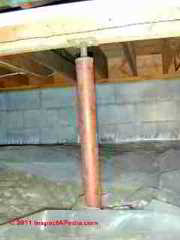
Our next structural column photo (above ) shows a thin-walled adjustable column in use in a wet crawl area. The repair contractor installed gravel and then plastic to keep moisture levels down in the crawl space.
(The post is probably not out of plumb, that was a tilt in the camera when I shot this photo.)
But notice that the column extends down through the gravel into the presumably wet surface beneath.
Consider that the end of the column is now hidden from view in gravel, that we think this is a recurrent wet area, we can't see if it's wet or not, and more, because this is a tight crawl space, people won't enter it very often to inspect conditions there.
A more durable repair would have been a Lally column. Some builders even prefer to use a pressure treated wood 4x4 post in this sort of location, arguing that it is "rustproof".
Some Adjustable Teleposts May be Permitted for Permanent Installation
Shown here, some adjustable screw jacks or teleposts such as some Read-I-Post columns are constructed of a heavier-gauge steel and in some jurisdictions they may be approved for permanent use in structures.
Often where an adjustable column is permitted for permanent structural use, once it has been properly adjusted in height, its adjusting rod is removed and the screw is tack-welded in place.
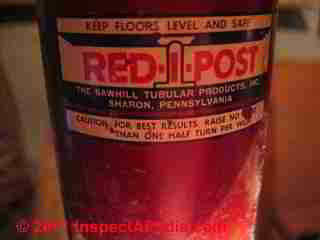
Notice that the installer took care to bolt the Red-I-Post top plate to the beam underside. Let's hope that the beam itself is secured to the floor joists overhead and is protected against lateral movement.
Pipes are Not Acceptable as Structural Columns
Our photo (above left) shows a basement girder supported by cute little 2-inch pipes.
We think the installer knew these were not structural-components, because s/he installed these toy "faux-structural" pipes on 5-foot centers.
Improper Column Top or Bottom Support, Bearing, or Connections
See our page top photo for an example of a horrible installation of a jackpost that is likely to collapse.
Below are more examples of improper telepost installations. At below left we have inadequate bearing surface and no connection between the steel bearing plate and the joist underside.
It looks as if the post may also be out of plumb. Boing!
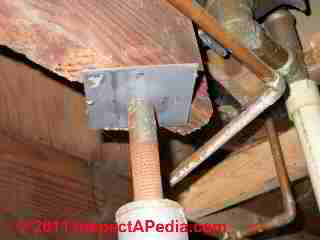 ...
... 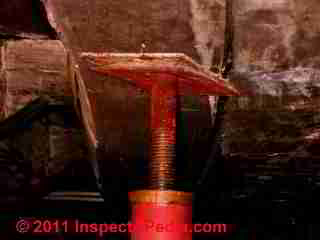
Which End Goes Up When Installing Screw Jacks & Teleposts?
Our second dangerous telepost photo at above right you can see that the post top screw has bent the steel plate as it pushed into the beam, and the whole assembly is slipping off of the beam and moving to the right.
Some installers place screw jacks or teleposts with the screw down against the concrete floor or pier top.
That allows the larger-diameter post "bottom" to be placed up against a steel plate and against the underside of the beam.
This "upside down" installation reduces the chances of bending the steel supporting plate and it also places the thick steel screw down on the (often wet) basement or crawl space floor.
The thicker steel screw is slower to rust through to the point of collapse than is the thin-walled hollow steel pipe that forms the body of most teleposts.
Supporting Column Location
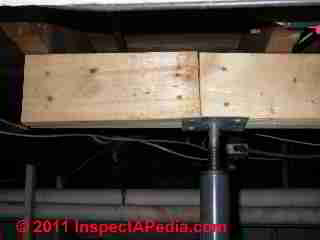
It seems obvious that in addition to spacing requirements for supporting steel columns below beams (typically a steel column is placed every eight feet on center in a wood frame two story residential structure), you would also place the column below any splices in the beam.
But a splice in a structural beam also needs resistance to bending upwards. Look closely (click any of our images to see a larger view) and you'll see some nice wood putty in that opening splice joint.
The splice shown in our photo of a home in Portland ME would probably not have bent if it had been located below that floor joist to the right, and had the supporting column placed below the splice as well as below the joists.
Improper (Hollow) Structural Columns Failed at 1994 Northridge Meadows Earthquake
As we also discuss at EARTHQUAKE DAMAGED FOUNDATIONS, defective supporting columns failed at Northridge Meadows during that 1994 earthquake.
It appears that hollow 6" pipes were substituted for concrete filled steel Lally columns under part of the building. Once the fireproofing wrap was installed it was not possible to spot this shortcut by visual inspection.
The hollow columns failed, permitting the upper floors of the structure to collapse. There were fatalities.
Here are examples of types of omission that contributed to a structural collapse. During our work at the Northridge Earthquake site in California in 1994 we noticed that some of the supporting Lally columns were hollow rather than concrete filled.
Perhaps due to material shortages or rush during construction, these hollow, and weaker supporting columns were wrapped with a fire-barrier just as were the "real" supporting columns used elsewhere.
Our photos show a section of Northridge Meadows which collapsed during the earthquake. In the second Northridge Meadows building collapse photograph just above you can see that this column was hollow.
Our opinion was that these were defective columns and that they were a factor in the structural collapse during the Northridge earthquake.
Other areas of the same complex moved, columns even leaned, but they did not collapse where the columns were of the proper type and were properly connected to the structure.
Other factors in the collapse appeared to include how exterior sheathing had been nailed across or not across certain sections of the building supporting walls. Our list of examples of defects of omission during foundation construction continues below.
See EARTHQUAKE DAMAGED FOUNDATIONS for more about the defective supporting columns that failed at Northridge Meadows during that 1994 earthquake.
Missing or Improperly-Removed Structural Columns & Posts
This topic has moved to a separate article now found at COLUMN / POST MISSING - separate article
Watch out: in a structural brick wall-built building, if one or more main beams lose their support, sag, and collapse, there is a high risk of a total catastrophic structural collapse.
Settling or Missing Column Footings & Piers Show up As Cracks, Sags, Movement
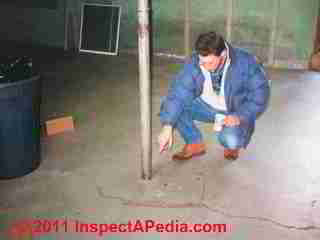 Missing Post or Column Footings / Piers
Missing Post or Column Footings / Piers
"Missing" column footings or piers may or may not be a defect depending on design and soil conditions. In some jurisdictions, a poured concrete floor slab may be considered of sufficient thickness and strength to support the column.
Of course one cannot, without special equipment, "see" through a concrete slab to determine whether or not a pier was provided or required below a post.
But in some instances there will be compelling evidence of a missing pier under the slab.
- Slab settlement:
Settlement Crack patterns that surround the bottom of a post often indicate slab settlement around an existing pier.
You might confirm that hypothesis by noting that the post itself has not settled and that the slab outside of the surrounding cracks is lower than the slab around the post bottom. - Pier missing:
Settlement Crack patterns around a post or column can also indicate a missing or settling pier if the slab concrete around the post is lower than the surrounding floor. - Post / Pier settlement:
On occasion we see evidence of post settlement through the slab even though the slab itself shows no cracks nor settlement around the post.
A classic example of this situation is the presence of a gap between the post top and the beam that it should be supporting. (Remember to check that no one has removed a shim that was previously in that space.)
What causes pier or slab settlement around or below a post?
Failure to compact the soil under a column pier or footing or under a poured concrete slab which has been placed on backfill can result in column settlement.
Our client is pointing to a supporting column in a location where we suspect that crack pattern around the column, combined with a slight but observable depression at the column base area suggests its pier may be settling.
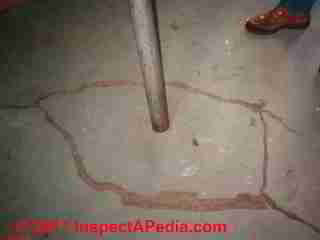
When we see a column whose base penetrates the concrete floor slab we know the floor was poured around the column - the column was put in place first. We can't see if a proper pier was installed to support the column base - as is usually the case.
Perhaps in the installation we show here, the builder set a 4-inch solid concrete block on (poorly-compacted) fill inside the building foundation, set his post on that, and jacked away. When the fill settles the block settles too, and the column may move downwards, cracking the concrete floor around its base in the pattern we show here.
- Omitted steel reinforcement -
footings missing re-bar or other required steel rods (not visibly detectable after construction) may show up as breaks or cracks and settlement around a post that rests just on the floor slab - Missing piers
beneath interior or exterior posts may be visible as post settlement or movement downwards through the floor slab without cracks in the slab itself.
Evaluate Rusted Steel Structural Columns & Posts
Please see COLUMN / POST RUST DAMAGE where we have moved and expanded the discussion of rust or dent damage to structural steel columns, posts, or jackposts.
Reinforcement & Structural Requirements for Masonry Block Columns
Illustration: excerpted from NCMA's concrete column design cited below.
Masonry Block or Concrete Column Design & Reinforcement
- Column cross-section dimensions
Concrete block or concrete columns should have dimensions of at least 8" x 8". - Column construction
Columns can be formed by formwork onall four sides or formwork on two sides with masonry block-work on the other two sides.
When using CMU blocks the blocks are lowered successively over the standing re-bar onto a mortar base. - Column height
Maximum height for an 8-inch concrete column is 15.9 ft (4.8m) - taller larger columns up to 20 ft. (6.1m) are permitted with additional reinforcement requirements - see NCMA specifications below. - Minimum column reinforcement
is 4- ½ diameter bars with ¼" stirrups at 6" centres. - OAS cited below - Lateral ties in masonry columns
shall be spaced not more than 8 inches (203 mm) on center and shall be not less than 3/8-inch (9.5 mm) diameter. Lateral ties shall be embedded in grout. - IRC R606.12.3.3 Wall Construction, Minimum Reinforcement for Masonry Columns
Note that this does not pertain to masonry columns that are built into a concrete or masonry wall provided that the wall meets other structure and fire resistance ratings given in Section R 722.2.4.2 and Section 716
- Column reinforcing re-bar
should be continous from the footing to the top of the column. When reinforcement bars need to be overlapped and tied together there should be at least a 16-inch overlap. - Columns, reinforcement spacing
See 10.6, Columns, Reinforcement Limits, 10.7, Columns, Reinforcement Detailing, 10.7.2, Columns, Reinforcement Spacing and Chapter 25.2 Minimum Spacing of Reinforcement - numerous details beyond the scope of this page.
- Column drip cap
Outdoors columns should have a drip cap
Watch out: local building regulations vary, and in areas of special risk such as hillsides or seismic zones, additional masonry column contruction requirements such as spacing, anchor bolts, and lateral ties are likey to be imposed.
Concrete Block or Concrete Column Footings
- Individual reinforced concrete columns or concrete block columns should be supported on square footings no less than 2’-0" square and 12" thick.
- Columns footing reinforcement should be noless than ½" diameter bars on 6" centrers in both directions forming a 6" mesh. - OAS cited below
Structural Column Construction Guidelines
- ACI, BUILDING CODE REQUIREMENTS FOR
STRUCTURAL CONCRETE (ACI 318-05) AND
COMMENTARY (ACI 318R-05) [PDF] ACI, retrieved 2022/02/15 original source: https://www.oaxaca.gob.mx/sinfra/wp-content/ uploads/sites/ 14/2016/02/aci_318-05_building_code_requirements _for_structural_concrete_and_ commentary_aci_318r-05.pdf
Note: ACI 318-05 is deemed to satisfy ISO 19338, “Performance and Assessment Requirements for Design Standards on Structural
Concrete,” Reference Number ISO 19338.2003(E). Also Technical Corrigendum 1: 2004.
Excerpt:
The code portion of this document covers the design and construction of structural concrete used in buildings and where applicable in nonbuilding structures. Among the subjects covered are: drawings and specifications; inspection; materials; durability requirements; concrete quality, mixing, and placing; formwork; embedded pipes;
construction joints; reinforcement details; analysis and design; strength and serviceability; flexural and axial loads; shear and torsion; development and splices of reinforcement; slab systems; walls; footings; precast concrete; composite flexural members; prestressed concrete; shells and folded plate members; strength evaluation of
existing structures; special provisions for seismic design; structural plain concrete; strut-and-tie modeling in Appendix A; alternative design provisions in Appendix B; alternative load and strength-reduction factors in Appendix C; and anchoring to concrete in Appendix D. - Building Code Requirements for Masonry Structures, ACI 530-99/ASCE 5-99/TMS 402-99. Reported by the Masonry Standards Joint Committee, 1999.
- CA, STANDARD CMU BLOCK WALL DETAIL [PDF] California, "Building in California", buildingincalifornia.com
P.O.#11125
Oakland, California 94611
United States
info@buildingincalifornia.com - retrieved 2022/02/15 original source: https://www.buildingincalifornia.com/wp-content/uploads/2014/01/CMUBlockWallDetail.pdf Building in
California provides a state-wide guide to the California building codes. - Japan, SIMPLIFIED CONSTRUCTION HANDBOOK for SCHOOL BUILDINGS [PDF] (2014) Department of Public Works & Highways, Japan International Cooperation Agency, et als. - retrieved 2022/02/15 original source: https://www.dpwh.gov.ph/dpwh/sites/default/files/Simplified%20Construction%20Handbook.pdf
- KS, R606.12.3.2 Minimum Reinforcement Requirements for Masonry Walls [PDF] Residential Code 2018 of Kansas, based on the IRC R606.12
- Matthys, John. H., ed. Masonry Designer’s Guide. The Masonry Society and the American Concrete Institute, 1999.
- NCMA, ALLOWABLE STRESS DESIGN OF CONCRETE MASONRY COLUMNS [PDF] NCMA, National Concrete Masonry Association, 13750 Sunrise Valley Drive Herndon, VA 20171 USA, Tel: 703.713.1900 Email: info@ncma.org - retrieved 2022/02/15 original source: https://ncma.org/resource/allowable-stress-design-of-concrete-masonry-columns/
- NCMA, ALLOWABLE STRESS DESIGN OF CONCRETE MASONRY PILASTERS, [PDF] TEK 17-04B, NCMA, Op. Cit., retrieved 2022/02/15 original source: https://ncma.org/resource/allowable-stress-design-of-concrete-masonry-pilasters/
- NCMA, FIRE RESISTANCE RATINGS OF CONCRETE MASONRY ASSEMBLIES [PDF] TEK 07-01d, NCMA, Op. Cit., - https://ncma.org/resource/fire-resistance-ratings-of-concrete-masonry-assemblies/
Excerpt:
Concrete masonry is widely specified for fire walls and fire barriers because concrete masonry is noncombustible, provides durable fire resistance, and is economical to construct.
Chapter 7 of the International Building Code (IBC) (refs. 2, 3) governs materials and assemblies used for structural fire resistance and fire-rated separation of adjacent spaces.
This TEK is based on the provisions of Code Requirements for Determining Fire Resistance of Concrete and Masonry Construction Assemblies, ACI/TMS 216.1 (ref. 1), which outlines a procedure to calculate the fire resistance ratings of concrete masonry assemblies.
The 2014 edition of the ACI/TMS 216.1 is referenced by the 2015 and 2018 IBC for concrete and masonry materials. - NCMA, STEEL COLUMN FIRE PROTECTION [PDF] NCMA, Op. Cit. - https://ncma.org/resource/steel-column-fire-protection/
- OAS, CONCRETE CONSTRUCTION BUILDING GUIDELINES [PDF] OAS, Organization of American States, 17th Street and Constitution Ave., NW Washington, D.C., 20006-4499 United States of America Main Telephone: 1 (202) 370 5000 - retrieved 2022/02/15 original source: https://www.oas.org/pgdm/document/codedraw/sectionb.htm
- UK, Eurocodes, EN 1996-1-1 REINFORCED MASONRY DESIGN EXAMPLE 3 [PDF] P. Watt (2009) - retrieved 2022/02/15, original source: https://eurocodes.jrc.ec.europa.eu/doc/WS2009/3_pm_Watt_c.pdf
Excerpt:
Reinforced Masonry – Reinforced Hollow Concrete Blockwork Column Subjected To Uniaxial Bending Design a 3,0m high reinforced hollow concrete blockwork column to carry a design vertical load of 400kN (NEd)and a design bending moment of 45kN.m (MEd).
If the height of the column is increased to 6,0m also assess the effect this has on the column section chosen?
The blocks to be used are dense aggregate concrete with a compressive strength (nonnormalised) of 10,4N/mm2 .
The concrete block masonry units are Group 2 of work size 440 by 215 by 215mm high with 35% voids ratio and of category I manufacturing control.
The mortar is a class M6 (designation ii) General Purpose mortar with the work being constructed to class 1 execution control. The infill concrete is a C35/45. Trial column section is 440 by 440mm.
Reader Comments, Questions & Answers About The Article Above
Below you will find questions and answers previously posted on this page at its page bottom reader comment box.
Reader Q&A - also see RECOMMENDED ARTICLES & FAQs
On 2023-04-21 y InspectApedia Publisher (mod) - New Basement Posts - Significant Settlement / Sinking Damage Assessment?
@RE-posted from private email,
It sounds as if you've got a reasonable diagnosis of the movement problem-cause: improper construction of the supporting posts, perhaps because they were not set on adequate footings and/or were placed on soft soil or fill.
About your worry about the roof trusses, it is a reasonable concern, particularly if your roof is framed with trusses whose members are joined together by steel pressed-on truss plates.
At https://inspectapedia.com/structure/Floor_or_Roof_Trusses.php TRUSSES, FLOOR & ROOF
you'll see photos of various types of truss damage that can be easily seen by direct visual inspection: that might be a place to start addressing that concern.
Let me know where you are in this matter and what questions remain and if we can be of further help we'll do what we can. Keep in mind that no remote text exchange can substitute for an onsite expert but often we can help you understand what you're seeing or what you're being told.
On 2023-04-21 by RE-posted from private email (mod)
Kenny said
New Basement Posts - Significant Settlement / Sinking Damage Assessment?
We live in northeast Missouri in a double wide on a walk out basement. We have lived in our home for 15 years. The home was already here when we bought it from a gentleman after he purchased through foreclosure.
About 3 years ago, we paid Foundation Recovery Systems to place french drain system, a large sump pump, whole house dehumidifier, wall anchors, and to replace the center supports.
We spent around $38,000 in two separate transactions. We then paid a separate contractor $10,000 to replace the windows and french door on the wooden walkout wide due to damage from water.
We are now left with issues of the center support beams not properly supported and the house is shifting, cabinets pulling away from the walls upstairs, floors uneven, new cracks in the walls, and enlarging gaps in the vaulted ceiling peak.
Foundation Recovery finally hired an engineer and the report is minimal compared to what the engineer said to us during the walk-through. It appears the new basements posts have settled too far causing the frame to be improperly supported, flattening out the roof.
His recommendation is to jack up the supports again. My basement floor is now chopped up with the many drains added, and I am very concerned about what is happening up above my home. Are the trusses broken? Will my roof start leaking. We need some advise please.
On 2023-02-14 y InspectApedia Editor (mod)
@AS,
Glad to be of help.
We very much welcome critique, questions, photos or content suggestions for our web articles.
On 2023-02-14 by AS
@InspectApedia Editor , I appreciate the fast response. We are planning on putting up a wall there anyway so this just helps my peace of mind. Thankyou for your input.
On 2023-02-14 by InspectApedia Editor (mod)
@AS,
That looks like normal beam checking and not cause for concern unless a crack is compromising a structural connector which I don't see here.
Both of these articles will provide a more thorough discussion on this topic
EVALUATE CRACKS & SPLITS IN WOOD BEAMS OR POSTS
and
REPAIR CRACKS & SPLITS IN WOOD BEAMS OR POSTS
My opinion is that a 2x6 wall or adding a sister post would add support but isn't necessary.
After seeing the recommended articles, please let us know if you have additional questions.
On 2023-02-14 by AS
Hello,
Im planning on finishing the basement of my house (1910's) and one item of concern for me is one of the original columns for the house.
It has significant checking on one face of the 6x6. It does not pass through the post but it would be something I would like to address before progressing.
My initial plan is to put up 2x6 walls along the beam to give extra support but if it requires replacement I would like to do that now. Would a 2x6 wall provide enough support or would it require additional sistering/replacement?
On 2022-10-29 by InspectApedia-911 (mod)
@Brandi,
You don't have to make the purchase contingent on the results of a professional inspection but that should certainly not prevent you from bringing in a professional so that you know what you are buying.
It's crazy to think that you should be forced to buy the most expensive purchase that most people ever make in their life without being allowed to look at it.
If someone refuse to permit me to actually look at the house that I was buying and to bring someone with me to help me do that then I would shop elsewhere.
On 2022-10-29 by Brandi - foam sealed crack in poured concrete foundation wall
@InspectApedia-911, thank you so much!
Unfortunately in the housing market in my area is so crazy that my offers are not accepted because I put in inspection. The last one, my offer was the highest and I still lost out because of it.
I hadn’t considered the pattern and was only thinking because it is right under the steel beam. There are not many other cracks. A few outside. I am in northeast PA
I wish I could inspect the houses before putting in offer but they sell in a few days and so far that hasn’t been possible. I appreciate your time to answer my question. There are 2 other cracks I could see from outside, but I didn’t think they were as bad.
On 2022-10-29 by InspectApedia-911 (mod)
@Brandi,
I think you are showing a poured concrete foundation wall. (That's not a column failure.)
There's so much goop over the crack that I can't see it to even understand the crack pattern.
The group which may be foam or epoxy or sealant or something else suggests that someone was definitely aware of the crack was trying to solve a problem.
It's possible they were trying to stop water entry.
Certainly a superficial application like that wouldn't be a structural repair.
Any such problem is repairable.
The questions are more what is the cost and what is the urgency.
We could make more useful comment if we could actually see the crack pattern.
Is it wider at the top or wider at the bottom? Are there other cracks? And we need to understand the cause and the impact on the structure before we know it's urgency.
There are many surrounding observations that need to be made to understand what's going on.
The country and city of location, the climate, the age of the building, the condition of roof runoff and surface runoff and water and frost versus settlement or heaving or clay soils.
As you see asking anyone to diagnosis they have not a shred of information about the house is like trying to inspect the house through the eye of a needle.
There would be so much speculation that the answer would not be reliable.
Surely you wouldn't buy a house without a thorough home inspection.
The home inspector should be able to tell you considerably more than we can see in this photo.
Armed with some actual information we could make more useful comments.
On 2022-10-29 by Brandi
Hi there, Is this a fixable situation? I am interested in a house and I am unsure how bad this crack is because it is right under support beam. Any help is greatly appreciated. Thank you!
Question: is this CMU Column too tall?
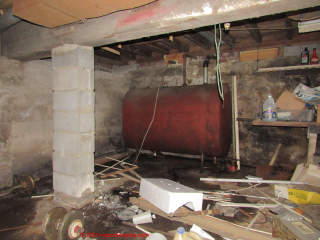 Last year at one of the NYASHI remote classes I recall the engineer pointing out that there is an issue with CMU stacked too high. Just not sure what the concern was. Appreciate if you could enlighten me..
Last year at one of the NYASHI remote classes I recall the engineer pointing out that there is an issue with CMU stacked too high. Just not sure what the concern was. Appreciate if you could enlighten me..
I know that in the picture there is an issue with water and an older oil tank in the basement. - DovBer Kahn
Moderator reply: questions about the column & foundation shown in this photo
Thanks for the question - it's not one on which I'm expert as I suspect the presentation you cite contained more detail than I've documented on this page.
I can't quite make out the number of blocks in your photo. Depending on the block dimensions the column may be taller than permitted for that block dimension.
But it looks as if there are 7 full blocks and one partial block (buried in the slab, with no view of the actual footing - if any)
Those blocks might be 10" x 8" x 16" or perhaps 12" x 8" x 16" making the column less than 8 ft. in height.
There are other home inspection and diagnostic questions about this building, perhaps ones you've already considered, including at least: :
- Is there reinforcement in the column and is the column connected to the overhead beam?
- Why is the block so close to what one would think is a supporting wall?
- Was the original supporting wall failing?
- Are there other columns?
- At what horizontal spacing under that large concrete beam?
- How old is the home,
- What other foundation damage is there - it's obviously a wet basement with a history of water entry through the block wall (esp. on the wall at the oil tank).
- Are that concrete beam and block column original construction or a repair?
Above on this page at
MASONRY COLUMN STRUCTURAL REQUIREMENTS you'll see the limitations on CMU column height and requirements for re-bar reinforcement - something you may have trouble seeing once construction is completed and the column is in place.
- Dov Ber Kahn, a home inspector in Rockland County, NY has contributed photographs of various building features. Mr. Kahn is a licensed home inspector in New York and New Jersey, and can be reached at Website: Kahnbhomeinspectors, Tel: 845-445-8234, Email: kdovber@googlemail.com
On 2020-07-15 by Anonymous - concrete-filled steel lally column OK to use Outdoors
Graham
A concrete-filled steel lally column is perfectly suitable and functional Outdoors particularly if kept painted and has the feature that it's easy to make a welded connection to a steel being that it is supporting.
I don't think there's any valid support for a claim that a steel post wicks moisture up from the ground.
On the other hand I would very steel and I would protect the bottom from moisture. On the 3rd hand would need similar protection. That's why regardless of post type it's better practice to support the bottom of the post buying a pier that rises above grade level.
Maybe you're a builder, who sounds as if she's not familiar with structural steel post, was thinking of a hollow pipe. That's not a lally column.
On 2020-07-15 by Graham
Hi,
We have had some drawings back from the structural engineer which have a metal post on it to help support a steel on the ground floor.
The builder said that he is not keen on using a metal post and would rather build a brick pier as the metal tends to allow moisture to rise up from the ground level into the main building.
We have wooden floorboards on our ground floor.
Your thought greatly appreciated.
On 2019-05-04 by (mod) - how to diagnose bent-lally columns
 Efra:
Efra:
Thanks for the interesting question and bent-lally column photos.
Our photo shows a bent-over Lally column at Northridge Meadows in LA after a major earthquake there. Some of those were not true Lallys but instead were hollow steel that bent over too-easily.
1. What's bent?
First double check that it's the column that's bent and not the 2x4 or 1x4 you're using as a strait edge. Check by flipping the lumber over or moving it around the post - or use a known-strait edge object.
2. Is it a true concretre-filled Lally column?
Next using a small hammer, TAP on the Lally column. In proper modern construction Lally columns are not hollow, they're filled with concrete - which resists bending under load. If the Lally column rings or sounds hollow I worry that the proper column was not installed.
(In SOME jurisdictions the local building inspector may permit hollow steel or temporary jackposts or screw jacks as permanent columns as long as the screw is welded when construction is complete but those are easy to identify by their holes and cross-bolts).
3. Are hollow columns or jackposts allowed?
Check with your local building department about allowing hollow steel columns; include the column diameter, height, and description of your building - are there unusual (for residential construction) weights or loads from above?
4. Is Engineering analysis needed?
Particularly since you think the bends are increasing I'd take this question seriously as a building collapse can injure or kill its occupants - which unfortunately means finding a civil engineer or structural engineer who is familiar with residential construction (not a generic engineer who may be licensed but lack the specific residential construction expertise) - and ask the engineer to take a look.
Keep me posted and we may be able to offer more comments as may other readers.
On 2019-05-04 by Efra
Hi, duplicate post. I didn't realize I could only upload one image.
To recap: im in a new construction. when i moved in i noticed one of the Lally columns was really bent (first pic, top left). the builder assured me this was nothing structural, and that most likely the column had been hit prior to its install.
one year later, i'm prepping to file the one year warranty claim with the builder, and noticed another column is noticeably bent (second lally column pic, top right). no cracking on the basement floor or anything.
is this normal? is there any way to know if there's something going on structurally that i should be worried about or be asking they fix (if possible)?
i also noticed the carrying beams ( i think that's what they're called) separate slightly from each other as they extend from Lally column to Lally column (bottom pic). not sure its super clear in the pic but i wonder if this too is normal.
Thanks everyone and I apologize to the moderator for the duplicity.
Efra
IMAGE LOST by older version of Clark Van Oyen’s Comments Box code - now fixed. Please re-post the image if you can. Sorry. Mod.
On 2019-05-04 by Efra
We're in a new construction home and we're one year in. When we first moved in, I noticed a significant bend on one of the Lally columns. I was told that the column had been likely hit or bent prior to its installation and that it had no bearing on structural integrity.
One year later, the column is still bent but I noticed slight bends in one of the other columns.
I attach images here in the hopes that someone can help me ascertain whether this is a problem or potentially a problem so I can be informed when filing me one year warranty claim with the builder.
Thanks everyone!
Efra
IMAGE LOST by older version of Clark Van Oyen’s Comments Box code - now fixed. Please re-post the image if you can. Sorry. Mod.
On 2017-12-05 by Clem
I have a cousin that built a cabin beside a lake 40” from water side of a hill and sandy soil.
Far as I know they only pored a 4” footing below a 2x6 treated wood frame. But you can see the 10’ high teleposts they used leaning a minimum of 4” off center from floor to floor joists.
My question is how far can a release post lean before it collapses?
On 2017-01-19 by jessi
concrete column out of plumb up to 20mm in verticality,how to rectify the same
...
Continue reading COLUMN / POST MISSING or select a topic from the closely-related articles below, or see the complete ARTICLE INDEX .
See COLUMN & POST FAQs - questions & answers posted originally on this page
Or see these
Recommended Articles
- BRACING for MASONRY CHIMNEYS
- COLUMN / POST MISSING
- COLUMN / POST RUST DAMAGE
- FOUNDATION DEFECTS OF OMISSION - MISSING
- PIER FOUNDATION PROBLEMS
- PORCH COLUMN REPAIR or REPLACEMENT for the repair of round or wood columns used on porches and in building interiors
- SETTLEMENT CRACKS in SLABS - settlement of piers below Lally columns
- SOIL PROPERTIES & BUILDING FAILURES
Suggested citation for this web page
COLUMNS & POSTS, DEFECTS at InspectApedia.com - online encyclopedia of building & environmental inspection, testing, diagnosis, repair, & problem prevention advice.
Or see this
INDEX to RELATED ARTICLES: ARTICLE INDEX to BUILDING STRUCTURES
Or use the SEARCH BOX found below to Ask a Question or Search InspectApedia
Ask a Question or Search InspectApedia
Try the search box just below, or if you prefer, post a question or comment in the Comments box below and we will respond promptly.
Search the InspectApedia website
Note: appearance of your Comment below may be delayed: if your comment contains an image, photograph, web link, or text that looks to the software as if it might be a web link, your posting will appear after it has been approved by a moderator. Apologies for the delay.
Only one image can be added per comment but you can post as many comments, and therefore images, as you like.
You will not receive a notification when a response to your question has been posted.
Please bookmark this page to make it easy for you to check back for our response.
Our Comment Box is provided by Countable Web Productions countable.ca
Citations & References
In addition to any citations in the article above, a full list is available on request.
- "Concrete Slab Finishes and the Use of the F-number System", Matthew Stuart, P.E., S.E., F.ASCE, online course at www.pdhonline.org/courses/s130/s130.htm
- Sal Alfano - Editor, Journal of Light Construction*
- Thanks to Alan Carson, Carson Dunlop, Associates, Toronto, for technical critique and some of the foundation inspection photographs cited in these articles
- Terry Carson - ASHI
- Mark Cramer - ASHI
- JD Grewell, ASHI
- Duncan Hannay - ASHI, P.E. *
- Bob Klewitz, M.S.C.E., P.E. - ASHI
- Ken Kruger, P.E., AIA - ASHI
- Aaron Kuertz aaronk@appliedtechnologies.com , with Applied Technologies regarding polyurethane foam sealant as other foundation crack repair product - 05/30/2007
- Bob Peterson, Magnum Piering - 800-771-7437 - FL*
- Arlene Puentes, ASHI, October Home Inspections - (845) 216-7833 - Kingston NY
- Greg Robi, Magnum Piering - 800-822-7437 - National*
- Dave Rathbun, P.E. - Geotech Engineering - 904-622-2424 FL*
- Ed Seaquist, P.E., SIE Assoc. - 301-269-1450 - National
- Dave Wickersheimer, P.E. R.A. - IL, professor, school of structures division, UIUC - University of Illinois at Urbana-Champaign School of Architecture. Professor Wickersheimer specializes in structural failure investigation and repair for wood and masonry construction. * Mr. Wickersheimer's engineering consulting service can be contacted at HDC Wickersheimer Engineering Services. (3/2010)
- *These reviewers have not returned comment 6/95
- Best Practices Guide to Residential Construction, by Steven Bliss. John Wiley & Sons, 2006. ISBN-10: 0471648361, ISBN-13: 978-0471648369, Hardcover: 320 pages, available from Amazon.com and also Wiley.com . See our book review of this publication.
- Building Pathology, Deterioration, Diagnostics, and Intervention, Samuel Y. Harris, P.E., AIA, Esq., ISBN 0-471-33172-4, John Wiley & Sons, 2001 [General building science-DF] ISBN-10: 0471331724 ISBN-13: 978-0471331728
- Building Pathology: Principles and Practice, David Watt, Wiley-Blackwell; 2 edition (March 7, 2008) ISBN-10: 1405161035 ISBN-13: 978-1405161039
- Diagnosing & Repairing House Structure Problems, Edgar O. Seaquist, McGraw Hill, 1980 ISBN 0-07-056013-7 (obsolete, incomplete, missing most diagnosis steps, but very good reading; out of print but used copies are available at Amazon.com, and reprints are available from some inspection tool suppliers). Ed Seaquist was among the first speakers invited to a series of educational conferences organized by D Friedman for ASHI, the American Society of Home Inspectors, where the topic of inspecting the in-service condition of building structures was first addressed.
- Design of Wood Structures - ASD, Donald E. Breyer, Kenneth Fridley, Kelly Cobeen, David Pollock, McGraw Hill, 2003, ISBN-10: 0071379320, ISBN-13: 978-0071379328
- Building Failures, Diagnosis & Avoidance, 2d Ed., W.H. Ransom, E.& F. Spon, New York, 1987 ISBN 0-419-14270-3
- Domestic Building Surveys, Andrew R. Williams, Kindle book, Amazon.com
- Defects and Deterioration in Buildings: A Practical Guide to the Science and Technology of Material Failure, Barry Richardson, Spon Press; 2d Ed (2001), ISBN-10: 041925210X, ISBN-13: 978-0419252108.>
- Guide to Domestic Building Surveys, Jack Bower, Butterworth Architecture, London, 1988, ISBN 0-408-50000 X
- "Avoiding Foundation Failures," Robert Marshall, Journal of Light Construction, July, 1996 (Highly recommend this article-DF)
- Quality Standards for the Professional Remodeling Industry, National Association of Home Builders Remodelers Council, NAHB Research Foundation, 1987.
- Quality Standards for the Professional Remodeler, N.U. Ahmed, # Home Builder Pr (February 1991), ISBN-10: 0867183594, ISBN-13: 978-0867183597
- In addition to citations & references found in this article, see the research citations given at the end of the related articles found at our suggested
CONTINUE READING or RECOMMENDED ARTICLES.
- Carson, Dunlop & Associates Ltd., 120 Carlton Street Suite 407, Toronto ON M5A 4K2. Tel: (416) 964-9415 1-800-268-7070 Email: info@carsondunlop.com. Alan Carson is a past president of ASHI, the American Society of Home Inspectors.
Thanks to Alan Carson and Bob Dunlop, for permission for InspectAPedia to use text excerpts from The HOME REFERENCE BOOK - the Encyclopedia of Homes and to use illustrations from The ILLUSTRATED HOME .
Carson Dunlop Associates provides extensive home inspection education and report writing material. In gratitude we provide links to tsome Carson Dunlop Associates products and services.


